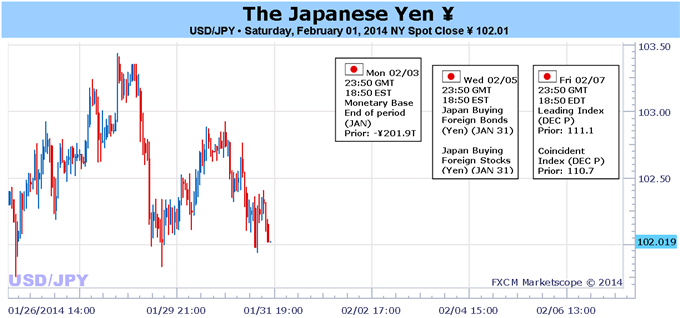
Fundamental Forecast for Japanese Yen: Bullish
– The Japanese Yen made a big lurch forward on compounding fears of slowing growth and emerging market crisis.
– A further deterioration in investor sentiment will help the Yen breakout of its recent triangles.
– Have a bearish (or bullish) bias on the Yen, but don’t know which pair to use? Use a Yen currency basket.
The Japanese Yen finished the week as the second best performer as evidence mounted that market participants have started to engage a more negative outlook into the near horizon. Emerging market troubles mounted for a second week, although after several desperate measures by central banks across the frontline developing world (Central and Southeast Asia, parts of Africa and Latin America), the Yen’s gains were focused elsewhere.
Throughout January, emerging market currencies like the Argentinian Peso, Russian Ruble, and South African Rand were getting punished by investors as the process of the Federal Reserve winding down QE3 started to provoke a more concerted reversal of “hot money” flows. With no major Japanese data on the calendar this week, our main focus will be on the continued unwind of these hot money flows. Capital flight bodes well for the Yen as the month of January proved.
This past week alone, data compiled by Bank of America Merrill Lynch illustrated these very points: emerging market equity funds saw -$6.4B in outflows; and emerging market bond funds saw -$3B in outflows. It’s too early to say that this is panic, but these are the seeds of a “sudden stop” in capital flows. Many historians point to the quick reversal of capital flows in the 1980s and 1990s as the catalyst for the Latin American and Asian crises, respectively.
Because global capital flow figures are compiled on a slower than desirable pace, their use to traders in real time leaves much to be desired. However, we can point to history to find similarities in investor behavior so as to narrow down the possibilities going forward. If so, recent equity and bond flow figures out of Japan (which will be updated this week with Thursday’s release) suggest that market participants are getting ready for further pressure in risk assets.
In particular, Japanese investors stopped putting money overseas in January. Japanese selling of foreign bonds averaged -¥383B each week of the month – or in other words, Japanese investors were worried about leaving their money abroad, and started to repatriate their funds. This stretch of four consecutive weeks of foreign bond selling is the first such occurrence since the weeks of May 17 to June 28, 2013 (six weeks), and during this time, the Yen was the best performing major currency. During this stretch, Japanese selling of foreign bonds averaged -¥873.9B; in a sense, the recent selling average is rather meager.
Additionally, it’s important to note that foreign buying of Japanese bonds for the week ended January 24 (¥623.3B) saw the highest rate of purchases since the week of July 19, 2013 (¥790.2B). In the three week after this spike in foreign interest in Japanese bonds in July, the USDJPY fell from above ¥100 to below ¥96 briefly in early-August. Panic could intensify if these numbers creep higher, and the Yen could benefit.
In light of these observations, it’s difficult to get behind a bearish stance for the Japanese Yen at present time. Fears are persisting, and until investors stop worrying – which will show up in the data in terms of capital flows reversing in emerging markets (increased flows to equity and bond funds) as well in Japan (Japanese investors will stop selling foreign bonds; and foreigners will stop buying Japanese bonds) – there’s little reason to proactively fight the Yen’s recent strength.
If these fears have developed because of the realization that era of ultra-loose monetary policy is ending, and the tapering of QE3 is a process that will take most of 2014, it would also be haphazard to point to a single date or event that might assuage recent worries. –CV
To receive reports from this analyst, sign up for Christopher’s distribution list.
DailyFX provides forex news and technical analysis on the trends that influence the global currency markets.Learn forex trading with a free practice account and trading charts from FXCM.
Source: Daily fx

